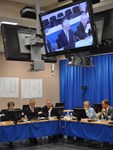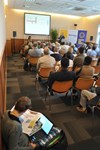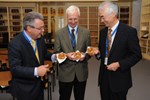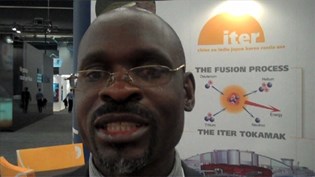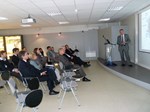A flag stands for a nation; several flags flying together can stand for much more than several nations ...
At ITER Headquarters on Friday, as Liman, Jean-Daniel, Kaushal, Shoko, Unkyu, Lana and Topher—the youngest among the ITER staff—hoisted the flag of their respective countries, the symbol was clear to everyone: out of a collection of nations with different and sometimes conflicting history, different cultures, different work habits, ITER has become a "family"—intent, in Deputy Director-General Chuyanov's words, on "achieving a great job."
There was emotion, and there was enthusiasm, as Director-General Motojima and the senior management stressed the importance of the task ahead, the necessity to work "even harder" and our responsibility to bring this project to full fruition.
Speaking for the Member they represent, each Deputy Director-General, or DDG representative, expressed pride in his country, explaining the meaning of its flag, sometimes recounting its history, or joking about the place it occupies amongst those of the other ITER Members.
Beyond that pride, however, was something even more valuable, expressed by the flag that Director-General Motojima hoisted last: the ITER flag, not the flag of a country but that of a project that is of the highest importance to every country.
The youngest among the ITER staff could jump for joy once the ceremony was over. ITER continues to gather momentum; our project is now visible for all, and Liman, Jean-Daniel, Kaushal, Shoko, Unkyu, Lana and Topher will see fusion go from our present large-scale scientific experiment to the every day reality of tomorrow's world.
When the ITER CLI, the Local Commission for Information for ITER, was established in December 2009, Kaname Ikeda, then ITER Director-General, defined it as "an opportunity for mutual understanding, a place where any question can be asked and all answers will be provided."
The CLI's third meeting, on Monday 27 September, in the Council Room at the Château fell perfectly into this definition.
"I have come here to make ITER a success—with you," DG Osamu Motojima told the assembled CLI members.
As the Preliminary Safety Report was being presented to the CLI members, there were indeed several questions asked, some harsh, most of them pertinent, and all were answered in detail by Director-General Osamu Motojima, Deputy Director-General Carlos Alejaldre, and Section Leader (Safety Design and Integration) Joëlle Elbez-Uzan.
The CLI, which is composed of members of Parliament, international experts, representatives from local communities, environmental groups, trade unions, businesses and health professionals "reflects the image of ITER in the local population," says Section Leader Bertrand Beaumont (Ion Cyclotron & Lower Hybrid) and the ITER staff representative at the CLI. "I see my role as an interface: I try to convey to my colleagues what the CLI expresses and worries about."
Jean Gonella, a math and physics professor at the Université de Provence in Marseille, explains that he is "neither pro- nor anti-ITER," but "fascinated by the project." A veteran activist, his purpose in joining the CLI was "democracy." "The debates we have here are good for the project and can contribute to make it better. During today's meeting, for example, we were provided with a lot of very useful information."
Does Gonella "trust" the information he is given? "I'm a scientist," he says, "and science is not founded on trust. Experts know, scientists doubt ..."
Whatever their background or their attitude toward the project—Maryse Joissains, the mayor of Aix-en-Provence and President of the Greater Aix Council renewed her commitment to ITER—most CLI members agree: information is a central issue. "I'm amazed at the abyss that lies between the reality of ITER and the perception, sometimes, of the general public," says Beaumont.
"It is difficult for an 'ordinary citizen' to have a clear idea about ITER. A lot of explanation, using simple words, is required," adds Gonella.
Some CLI members may appear to be and behave as "adversaries" of ITER. As Gonella says, however: "Nothing is better than an adversary to make progress toward the truth."
More than one hundred tonnes of niobium-tin (Nb3Sn) superconducting wire, all destined for the ITER toroidal field coils, have now been produced by the six ITER Domestic Agencies (China, EU, Japan, South Korea, Russia, and the US) responsible for toroidal field conductor procurement.
These 100 tonnes, about half of which come from Japan, amount to 25 percent of the total wire length (80,000 km!) that is required for ITER's 18 toroidal field coils, each as heavy as a fully loaded Boeing 747.
Niobium-titanium (NbTi ) superconducting wire production for ITER's poloidal field coils will begin next month, and by 2012 the first jacketed cables should arrive on-site for magnet winding.
This operation will be performed in the dedicated 250-metre-long building whose construction began early in August on the ITER platform.
Coordinating the conductor fabrication, implementing quality control, and dealing with the many issues that inevitably arise in such a complex and delicate process require a lot of interaction between the ITER Organization, the six Domestic Agencies and their industrial suppliers.
In order to closely monitor this process worldwide, video conferences and visits are organized on a regular basis and dozens of emails and phone calls are exchanged everyday.
But because nothing can replace personal contact and face-to-face negotiation, the main actors in conductor production—ITER Organization Magnet Division personnel, Domestic Agency Technical Responsible Officers, and representatives from industry—have got into the habit, since 2008, of meeting twice a year here in Cadarache.
"Gathering everyone involved in the same room for three days, having lunch together, looking for common ground and eventually finding it, creates a strong motivation," says Superconducting Systems Section Leader Arnaud Devred. "A video conference would never achieve the same results."
These "Conductor sub-IPT" meetings (IPT for "Integrated Project Team"), according to Arnaud, play an essential part in the "ability to produce" and in the success of the whole operation.
Such a meeting was held this past week in the Cadarache Château's Salle des Armures and gathered some 30 representatives from all the Members involved in toroidal field, poloidal field, and central solenoid conductor production. "We discuss dimensions, tolerances, tests and examination; we review, we deal with what we call 'deviation requests' ... we come out with guidelines for standardized procedures," says Arnaud. "We try to understand each other's point of view and we accommodate."
Every year since 1925, large and curious crowds of visitors have strolled along the hallways of the Foire Internationale de Marseille to discover the latest developments in appliances, services or technology.
The trade fair, which opened on Friday 24 September and which closed on Monday 4 October, is one of the oldest and most important in France, and draws an average of 400,000 visitors, 95 percent of them residents of the PACA region.
ITER has been present at the Foire Internationale since 2006. Volunteers from the ITER Organization, Agence Iter France, CEA-Institute for Magnetic Fusion Research (IRFM) and, this year, the European Domestic Agency, Fusion for Energy (F4E), man the ITER stand, hand out brochures and goodies to the public, and answer their many questions about the project.
Every year, a special "ITER Day" is organized with the participation of the ITER management, senior fusion scientists and various specialists involved in ITER. A press conference usually follows, which provides the local media with updates on the project's progress.
As works on the platform have become more and more "visible," interest in ITER has increased among the local population. For a long time, the project had remained an abstraction; it is now a reality for all to see.
"ITER Day," Wednesday 29 September, was a great opportunity for visitors to satisfy their curiosity.
In a packed conference room, fusion veteran Jean Jacquinot, former Head of JET and of CEA's Fusion Department, addressed the issue of the "future of energy"; Carlos Alejaldre, ITER Deputy Director-General, presented an update on the ITER Project, saying in his conclusion that "a million years from now, people will remember that the decisive steps in bringing fusion to mankind were made here, in France, in Provence ..."
In the afternoon, Laurent Schmieder, F4E Head of Site, talked about the construction of the installation and the economic impact on the region, and Nadia Fabre, a chief-engineer at the Regional Direction of Environment, Land Planning and Housing (DREAL) presented the ITER Itinerary, where the first test-convoy will be organized in less than a year—the first components being expected on site by mid-2012.
An efficient communication event is one that is fun—and fun it was to be served "exotic" foods on the ITER stand and to be invited by Agence Iter France to guess their origin. As there are seven ITER Members, there were only seven possible answers.
And after a lottery draw, the winners of the quiz could expect to be treated to a free flight for three over the ITER platform.
|
Vasco de Gama, Ferdinand Magellan, Christopher Columbus—the names of many great explorers are linked to Portugal. It was here, at the western tip of the European continent, where these brave men took off to discover new frontiers. This week, it was another generation of explorers that set sail in Portugal. 20 years after the Lisbon convention, the Symposium on Fusion Technology, better known as the SOFT conference, was back on Portuguese ground, in Porto.
The SOFT conference is an important gauge in measuring the progress made in the development of fusion energy. For its 26th edition—with more than 1,200 participants (200 from industry) and more than 170 poster presentations per day—the SOFT conference beat its own record.
Organizer Carlos Varandas, Chairman of the Governing Board of the European Domestic Agency Fusion for Energy (F4E), was "very impressed" by the large number of participants. Watching the crowds in the poster sessions, especially the many young scientists who had come from far away to present their latest research results on the development of fusion energy—whether tokamak, stellerator or inertial fusion—was indeed encouraging.
"This attention indicates the vitality of the fusion program," Varandas said, "and that has a lot to do with ITER." Varandas credits the increased participation to the fact that ITER is physically taking shape and that the project's Baseline is now approved. "The making of ITER has become a catalyst for fusion development."
Fritz Wagner, one of the many prominent senior scientists participating in the conference and who led a workshop on Large Scale Technology Facilities, was equally impressed. "It is fantastic to see the increasing importance of this conference. It gives us confidence and the young people an opportunity to get an update on the status of fusion research."
Rudolf Strohmeier, Deputy Director-General of the Research Directorate within the European Commission, described what that status is: "Fusion energy research is reaching a state of maturity."
This 26th SOFT was also the first opportunity for the ITER Director-General Osamu Motojima to address the assembled international fusion community and to report on the current status and his "action plan" for the ITER Project—a plan that builds on cost containment, improved coordination between the ITER Organization and the Domestic Agencies, and a staffing plan that aims to increase the number of staff from the Member States and increased efficiency in the organizational structures. "We also have to open the door for young people," Motojima concluded.
Driven by curiosity and determination, people like Magellan and Columbus set sail to discover a yet unknown world. Curiosity and determination are also the drivers for research. Research that will deliver the answers to still outstanding questions for the commercial development of fusion energy. The 26th Symposium on Fusion Technology has left no doubt on this.
In two years' time, 24-28 September 2012, the SOFT will move on to Liège, Belgium. www.soft2012.eu
UK industry has won well over £100 million (115.5 M€) worth of contracts so far from construction of the ITER fusion project in France, but needs to do better if it is to benefit from the next construction phase, worth up to EUR 2 billion (2.3 B€). That is one of the conclusions of a UK Trade & Investment (UKTI)-sponsored event on "Business Opportunities for UK plc for Fusion and ITER" held at Culham Centre for Fusion Energy (CCFE), Oxfordshire, on 23 September.
ITER will be the world's largest fusion energy experiment when it is completed in 2019. UK companies have fared well during the site preparation phase at Cadarache in the south of France. The next phase will see a large portion of the project's EUR 10 billion (11.5 B€) tokamak and buildings construction budget being spent.
Over 100 companies attended the one-day conference at which representatives from ITER, Europe's procurement agency for ITER Fusion for Energy (F4E), UKTI, CCFE engineers and UK companies working on ITER Project, reviewed the business opportunities and engineering challenges in the next phase of ITER construction, and described the procurement procedure and tendering process.
"The ITER Project faces significant engineering and project management challenges where UK companies can compete effectively—either on their own or as part of a consortium. ITER is providing new business opportunities to companies who are keen to use their expertise in this prestigious program," says Dan Mistry, Fusion and Industry Manager, CCFE.
"Currently UK is third in ranking (behind France and Italy) in contracts awarded but we want to be number one," adds Mistry. "The only way we're going to climb is if more companies take note of these opportunities and respond. F4E has nearly EUR 2 billion to spend in the next three years and we want to alert companies of these opportunities, so if you are interested please pre-qualify and register your details on ITER's, F4E's and our own database and join the list of successful companies—Atkins Global, Tessella, Halcrow, Jacobs, Oxford Technologies and Oxford Instruments to name but a few."
Companies wishing to find out more about ITER and how to register with ITER and F4E should contact Dan Mistry, Fusion and Industry manager, CCFE on 01235 466607 and email: dan.mistry@ccfe.ac.uk. They can also sign up for CCFE's industry database at: www.fusion-industry.org.uk.
As the project gathers momentum and gains in visibility, more and more visitors are greeted at ITER.
On Tuesday, 28 September, a group of twenty members of the European Parliament, technical advisors and members of the European Energy Forum, came to visit CEA facilities (RJH, Tore Supra, IBEB, solar platform) and ITER in order to have an overview of the present state of energy research.
The following day, a delegation of 21 representatives from NATO's sub-committee on Energy and Environmental Security, headed by French Member of Parliament Philippe Vitel, visited ITER and CEA and also several major companies and institutions established in the PACA region.
On Thursday 30 September, a ten-member delegation of Chinese Academy of Science was welcomed at ITER Headquarters by Director-General Osamu Motojima and later toured the ITER site with Deputy Director-General, Shaoqi Wang.
|




